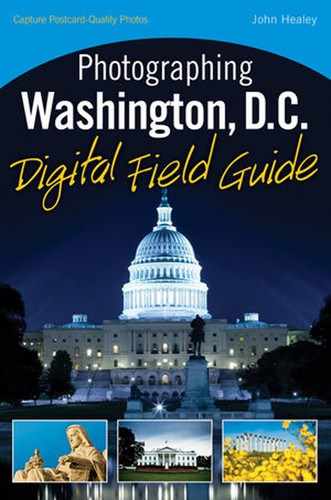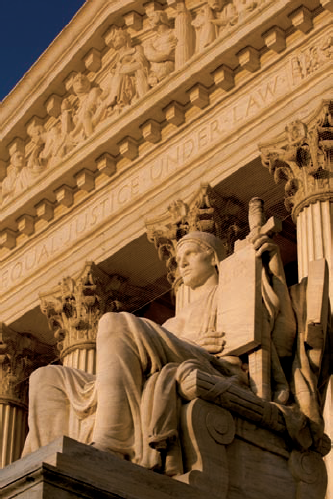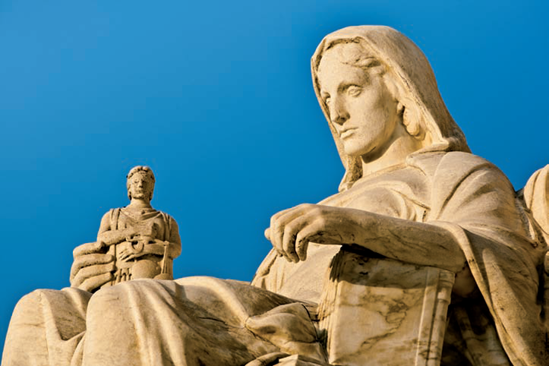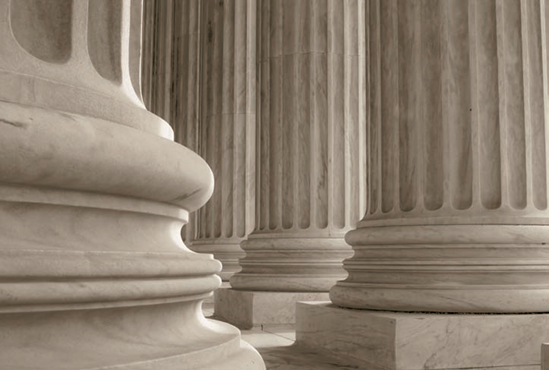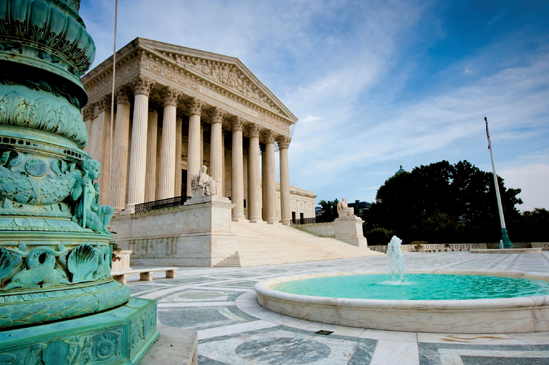
The west side of the Supreme Court Building of the United States. Taken at ISO 200, f/11, 1/125 second with a 20mm lens.
The Supreme Court of the United States presides over all federal and state courts and bears the ultimate authority for the interpretation of the Constitution of the United States of America.
The U.S. Supreme Court was 146 years old before it finally got its own building in 1935. Prior to that, the Court's judges met over the years in a series of rooms within the U.S. Capitol until Chief Justice William Howard Taft (the former President of the United States) persuaded Congress to give the Supreme Court a building of its own.
The front of the Supreme Court Building faces west. Its 16 marble columns, grand steps, and pediment that reads "Equal Justice Under Law" are all at once imposing and monumental. It's a beautiful sight that even the most jaded Washingtonian can't pass without taking a second glance.
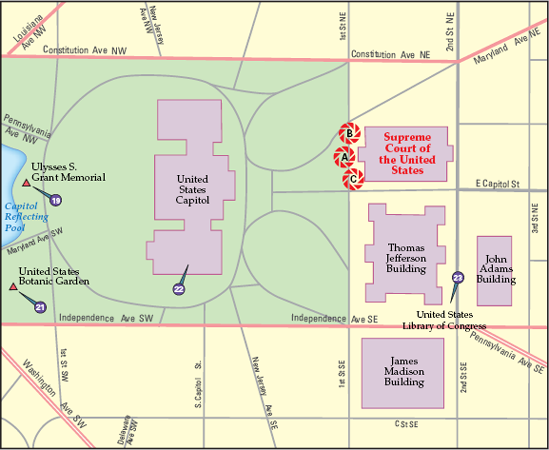
Figure 17.1. The best locations from which to photograph the Supreme Court of the United States: (A) west exterior facing east, (B) main steps, and (C) marble columns at west entrance. Nearby photo ops: (19) Ulysses S. Grant Memorial, (21) United States Botanic Garden, (22) United States Capitol, and (23) United States Library of Congress.
When photographing the west exterior of the Supreme Court Building, the late afternoon is your best bet for it being awash in golden sunlight (see Figure 17.1). You can use many different ways to photograph from here, but one that works especially well is to add foreground subjects to the image.
Such subjects can be the candelabra on either side of the first, low set of steps, flowers that surround the building, or the pools of water and seating areas to either side of the main steps. People who are coming and going add a great sense of scale to the building as well.
Sculptor James Earl Fraser's marble figures grace either side of the main steps of the Supreme Court Building. On the left is a female figure, the Contemplation of Justice; to the right the Guardian or Authority of Law (see Figure 17.2).
If you get to a spot below these figures, you can photograph them with the columns and pediment in the background, which makes for a wonderful photograph, especially with the late evening sun casting across both. You can also photograph them without the building in the background, which is a nice shot when the evening sky is a deep blue (see Figure 17.3).
If you want to photograph beautiful columns, those at the Supreme Court Building are some of the best you'll find in D.C. (see Figure 17.4).
The Supreme Court is one of the most beautiful buildings in Washington, D.C., although in 2006, a net was fastened to the west side's pediment after marble fell from the structure. Therefore, close-up photos of the pediment are less than optimal.
Photography at the Supreme Court Building requires some wide and long lenses and some extra careful attention to composition.
The Supreme Court Building is dauntingly large, and when you are up close to it, the vastness is striking. Moderately wide to normal lenses of between 35–50mm are good for shots from the lower stairs. When you get closer, you need a wide-angle lens of around 17–30mm, depending on how you are composing your shot. Detail shots of the marble figures on either side of the main steps require a lens from 100–200mm.
If you are shooting in the evening light and composing a shot that is perpendicular to the sun, a polarizing filter can make the sky a deep blue and enhance the contrast with the clouds. But, if you are shooting along the same axis as the sun, a polarizer's effect will be minimized — it is most effective when used perpendicular to the direction of the light.
If you want to keep the angles correct on the Supreme Court, you can use a tilt-shift lens. Using this lens allows you to correct the distortion that occurs when you point your camera up from a low position when photographing buildings; this distortion is known as converging lines. These highly specialized lenses are used by architectural photographers to keep the angles of buildings correct, despite a less-than-optimal shooting position. These lenses are quite expensive but are often stocked by rental dealers.
When photographing the front of the Supreme Court Building lit by the sun, the building will be very bright and your camera may underexpose the scene if you are using an automatic exposure mode. Use your camera's exposure compensation function to increase its exposure, or take a look at what exposure settings it is automatically setting in an automatic mode, then switch to Manual and slow down the shutter speed and/or open the aperture to increase the exposure.
Get a handle on what a good overall exposure looks like and then start shooting photos, because the exposure will likely not vary significantly. If you are using a camera that lacks manual functionality, you may try its Snow or Beach mode — both are designed for overly bright scenes.
To get the warm glow of the sun setting into the building (refer to Figure 17.1), set your color balance to its Sun mode and experiment with the other settings, such as the Shade mode to enhance the effect. During the day, the building can look clean and white while during the evening, it can glow orange in the final few minutes of sunlight. Choose your white balance based on your artistic preferences.
If you are photographing with something in the foreground, such as the candelabras, you will want to focus on those and set a fairly high aperture like f/11 to make sure that you get both the foreground elements and the background in focus, unless your artistic preferences say otherwise.
The Supreme Court Building is striking no matter what the time or the weather, but by using the setting sun, your photo becomes spectacular.
Because the building faces west, the afternoon and evening are nice times to photograph here. But don't discount early mornings or even midafternoon. An early-morning, colorful sky can be a great backdrop, and the minimalism of clean, overhead light can make for a stark, contrast-filled shot.
When the court is in session, the public can view oral arguments. During these times, lines will form early in the morning for the more prominent cases, which isn't the best time to visit and take photographs.
Tip
See the Court's Web site (www.supremecourtus.gov) for more information about these and other details about visiting.
Overcast skies produce soft shadows and even lighting, which are easy to work with here, especially to make black-and-white photos. If it's raining, umbrellas and the people under them can add a colorful and different look to an otherwise monochromatic scene here.
At night, the interior area behind the columns is illuminated, which offers more possibilities.
Like many of the other landmarks in D.C., the Supreme Court building has countless details here that can make for great photos. The massive doors of the west side of the building are ripe for macro shots, as are the intricate parts of the marble figures. Also, when you are at the top of the main stairs, the view through the columns to the Capitol can make for an interesting composition.
